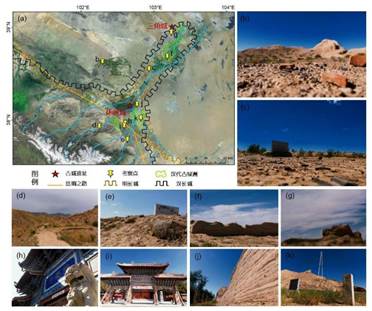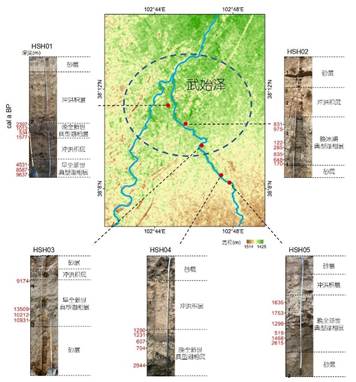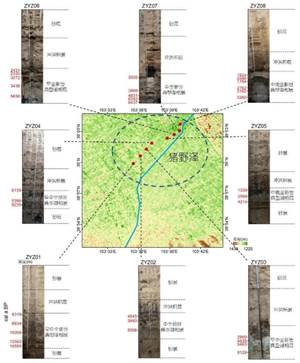Endorheic river basins and their terminal lakes are sensitive to climate change and human activities. Based on chronological and proxy data from sediment profiles of 13 lakes in the endorheic area of the Hexi Corridor, combined with river erosion/deposition rates, distribution patterns of ancient cities, cultural sites, and paleoclimatic simulations, Professor Li Yu and his team conducted research on the lake evolution process and its influencing factors during the Holocene.

Figure 1:Distribution of ancient cultural sites in the Shiyang River basin (a), with notable sites including Jinchang Triangular City (b), Liu Lake Dun (c), Wangjia Platform (d), Mozizi Site (e), Hongsha Fort (f), Liangucheng Site (g), Yintai Temple (h), Haizang Temple (i), Ming Dynasty Great Wall - Liangzhou Section (j), and Han Dynasty Great Wall - Liangzhou Section Current Status (k).

Figure 2:Lithology and lacustrine sediment strata AMS 14C dating results for profiles HSH01~05 surrounding Wushi Ze. The red numbers indicate typical lacustrine layer dates.

Figure 3:Lithology and lacustrine sediment strata AMS 14C dating results for profiles ZYZ01~08 surrounding Zhu Ye Ze. The red numbers indicate typical lacustrine layer dates.
The findings indicate that climate change and human activities have played key roles in the evolution of lakes in the Hexi Corridor. The East Asian monsoon and westerly winds, by influencing precipitation, control the water levels of terminal lakes[1,2]. From the Late Glacial to Early Holocene, ancient lakes such as Wushi Ze and Zhu Ye Ze in the Shiyang River basin began to develop; during the Mid-Holocene, the climate was humid, with large lakes and high water levels; and the Late Holocene aridification led to lake contraction and river incision[2]. Early human activities involved local modifications to rivers in the Hexi Corridor through water resource utilization, with minimal impact on the overall watershed's water allocation and lake evolution. Entering the historical period, human activities and climate change began to jointly affect runoff, water resources, and lake evolution, with human activities becoming the dominant factor in surface processes, evidenced by increased anthropogenic disturbances recorded in regional lake sediment proxy indicators[1].
This research was jointly supported by the National Natural Science Foundation of China and the Second Comprehensive Scientific Investigation of the Qinghai-Tibet Plateau. The results were published in "The evolution of river systems under the influence of climate change and human activities in the endorheic zones during the Holocene" in The Holocene and "Environmental changes and human activities in the Shiyang River basin since the Late Glacial" in Chinese Science Bulletin. Professor Li Yu's team has made significant progress in the study of lake evolution in the Hexi Corridor and global endorheic areas: regionally, they discovered that climate change and human activities have influenced surface processes, lake evolution, and organic carbon storage in the Hexi Corridor during the historical period[3-4]; globally, they identified temporal and spatial scale effects in the interaction between humans and the environment in endorheic areas during the Holocene[5], with human impacts on sediment proxy indicators significantly increasing since the Industrial Revolution[6].
Related references:
[1] Gao and Li et al., 2024. Holocene.https://doi.org/10.1177/09596836241236344
[2] Li et al., 2023. Chinese Science Bulletin, 68, 3869-3884.https://doi.org/10.1360/TB-2022-0965
[3] Li et al., 2023. ERL, 18, 044035.https://doi.org/10.1088/1748-9326/acc87b
[4] Li et al., 2021. CBM, 16, 28.https://doi.org/10.1186/s13021-021-00191-6
[5] Li et al., 2023. JGS, 33, 1569-86.https://doi.org/10.1007/s11442-023-2143-5
[6] Li et al., 2021. JGS, 31, 765-784.https://doi.org/10.1007/s11442-021-1870-8